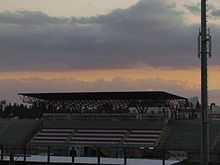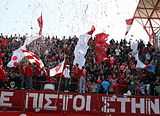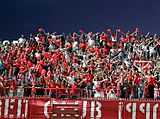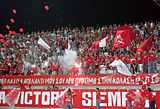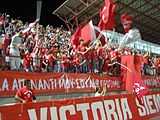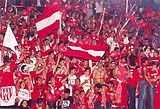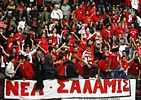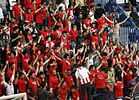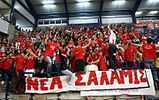Nea Salamis Famagusta
_Football_Club_logo_vector.svg.png) | |
| Full name |
Athletic Club Nea Salamis Famagusta Αθλητικό Σωματείο Νέα Σαλαμίς Αμμοχώστου |
|---|---|
| Founded | 1948 |
| Chairman | Andreas Paraskeva |
| Website | www.neasalamis.com.cy |
| Active departments of Nea Salamis | ||
|---|---|---|
| |
|
|
| Football | Volleyball | Parent Club |
Nea Salamis Famagusta or Nea Salamina Famagusta (Greek: Νέα Σαλαμίνα Αμμοχώστου) is a Cypriot sport club based in Ammochostos (also known by its Romanized name: Famagusta), Cyprus. The club is named after the ancient city of Cyprus, Salamis or Salamina, which is located nearby modern Famagusta. Today, the club maintains departments for men's football and volleyball. It previously operated football departments for women too, as well as track and field, water sports and table tennis.
Since the 1974 Turkish occupation of the north part of the island, Nea Salamina has been a "refugee" team and has been temporarily based in Larnaca since then.
Football department (men), is the oldest of the club's departments, founded in 1948. Nea Salamis' greatest moment was winning the Cypriot Cup and the Cypriot Super Cup in 1990. The football team is currently based at Ammochostos Stadium in Larnaka.
The volleyball team (men) is one of the most important in Cyprus. The team won 9 championships, 7 cups and 8 shields with six consecutive championships and cups from 1998 until 2003. The ground of the volleyball team is in Limassol, the indoor athletic arena Spyros Kyprianou Athletic Center.
History
The Early Years
At the time of the founding of Nea Salamina, Greece entered a period of civil war between leftists and rightists known as Greek Civil War. The situation in Greece affected Cyprus, infiltrating both the political life and sport.[1] Most athletes were also involved in politics. Famagusta at this time had two sport clubs, Evagoras Gymnastic Association GSE (Greek: Γυμναστικός Σύλλογος Ευαγόρας) and Anorthosis Famagusta FC. GSE had many leftist athletes on its rosters, who were some of the best athletes of Cyprus. At Anorthosis many players were also leftists. Under the influence of the right-wing political climate of that time, the GSE and Anorthosis began to impose restrictions on the admission of leftist members,[2][3] or denied promotion to players with left-wing leanings. From early 1947, a group of people from Famagusta, including leftists, members and non-members of GSE and Anorthosis, concluded that there was room for the creation of another sport club in the city. Due to the restrictions imposed, they envisioned a club which would appeal to everyone in Famagusta regardless of political affiliation.[1][3]
Following deliberations, on 14 February 1948[1][4] the final decision was taken to establish the club and efforts began setting it up and registering club members. After the successful efforts the New Salamina sports club was formed on Sunday, 7 March 1948[1][4] as the first leftist athletic club of Cyprus.[4] After the foundation of the club many citizens expressed their desire to join. The football section was not strong at that time as the majority of footballers who had joined were not very gifted.[5]

On 8 March 1948 the newspaper "Democratis" announced the establishment of the association in the following way under the title "A Progressive Movement in VAROSHA":[1][3]
Today at 11 a.m. in Hadjihambis theater the founding convention of a new sport club in our city, New Salamina took place. The board of directors consisted of Messrs. Andrew Paschalides, Georgio Fano, doctor, and Kostas Eleftheriou. Mr. G. Fanos stressed that the most progressive city of the island, Famagusta, hasn't had a political free sport club. He also emphasized the association's program as leading the city in cultural and sportive terms and invited all professionals and amateurs to join the new club.[1][3]
During the constituent assembly, the first nine board members of Nea Salamina were elected as follows:[1][4]
- Andreas Paschalidis (Chairman)
- George Fanos (Vice President)
- Kostas Eleftheriou (General Secretary)
- Michael Daniel Sialis (Treasurer)
- Antonis Totsis (Collector)
- Lycurgus Archontides (Head football)
- Nikos Kokkinos (Head football)
- Panagiotis Kalogirou (Head track)
The name
The constituent assembly decided to name the new club "Nea Salamis". The idea for the name came from a suggestion of Evagoras Lanitis. He came to the GSΕ stadium during Pancypriot games and reported that Anorthosis should be renamed Salamis because of ancient Salamis; this did not happen. One of the people who helped establish the club recalled the idea and proposed it and the majority adopted it. The constituent assembly chose as the official name the ATHLETIC CLUB "NEA SALAMIS" FAMAGUSTA (Greek: ΑΘΛΗΤΙΚΟΝ ΣΩΜΑΤΕΙΟΝ "ΝΕΑ ΣΑΛΑΜΙΣ" ΑΜΜΟΧΩΣΤΟΥ) ("Nea" means "new" in Greek language).[1][4]
Department creation
Many people soon joined the new club. They created athletic departments and football to offer to the club's youth. The team had prepared track athletes, but the football department was the coordinator for the creation of, and participation in, sporting events. The first official track events which took place Nea Salamina, were Famagusta's races on 25 March 1948 in the GSE stadium. Athletes of Nea Salamina swept their opponents. The participating athletes included Nikis Georgiou, Panayiotis Kalogirou, Antonis Totsis, Koumis Kkeses, Kostas Manoli, Nikos Kokkinos, Christofi Tsiakkiros. The reason for its success was the fact that all top athletes of GSE joined Nea Salamina. The football department recruited a few athletes from Anorthosis and for this reason, the team was not a power football team.[6]
Ejection from the GSE Stadium and the establishment of CAFF
Before the Pancyprian Games in May 1948, the Hellenic Amateur Athletic Association (SEGAS) asked all gymnastics associations in Cyprus, their members and athletes, to sign a public declaration that would express their support to the rightists in Greek Civil War, to declare that they espoused "nationalist beliefs" and to reprobate the leftists.[1][2] The rightist athletic clubs and athletes signed these statements. The only club that refused to sign the statement was the Gymnastic Association "Kinyras" Paphos, which was therefore excluded from the games. The leftist athletes were opposed to the declaration made by the clubs, and refused to sign the statement.[1][2] Among the first athletes who reacted were the champions of GSE, Antonis Totsis (Greek: Αντώνης Τότσης) and Nikis Georgiou (Greek: Νικής Γεωργίου). GSE invited the two athletes to apologize but both athletes insisted on their position that sports should stay away from politics.[7] In addition, the leftist athletes decided to support the Gymnastic Association "Kinyras" Paphos, if the decision to exclude it from Pancyprian Games was unchanged. Although they had many chances to compete and to win, the two athletes preferred to stand by Kinyras. GSE was considered as dominant for winning the first position in the competition,[2] but after those facts it took the third place at the end. As a reaction to the fact that athletes of Nea Salamina were not involved in the Pancyprian Games, GSE sent a letter to the club informing it that entry to the GSE Stadium was allowed for it.[1][2][7] The letter was signed by the President of GSE.[8] Deletions of other athletes of GSE and Anorthosis who stood by their teammates followed.[7] The prohibition on the use of the stadium caused a problem to Nea Salamina, as they were not able to use it for the participation in the new season's soccer league.[8]
Similarly, negative attitudes against leftist athletes prevailed in other Cypriot cities. In Larnaca, Alki Larnaca F.C. was founded in April. The month after, the Gymnastic Club Zeno (GSZ), banned Alki from using GSZ Stadium in a general meeting [2][7][8] A similar proposal to exclude Turks and Catholics was rejected. At the same general meeting, members of the GSZ, amended the relevant article of the constitution and prohibited any future enrollment of new members unless they had previously signed a declaration that "they espouse the Hellenic nationalistic ideals". Therefore, they took the decision to virtually exclude any leftist athletes from becoming members or using its stadium.[7] In May, Orfeas Nicosia was founded in Nicosia. In the same month APOEL F.C. sent a greeting by telegram to SEGAS ("cordial brotherly greetings to the entire Greek youth athletes"), on the occasion of National Games, and wished the cease of inner-nation mutiny. APOEL asked all members and athletes of the club to sign a declaration, supporting the content of the telegram. Leftist members and athletes of APOEL considered "inner-nation mutiny" as a challenge and political statement of the club, thus they distanced themselves from that statement. The Cypriot press stoked a hostile climate with their articles and comments.[2][7][8] This was followed by the indefinite suspension of five athletes of APOEL (Lympouris, Tsialis, Gogakis, Xatzivasileiou and Christodoulou) who founded a new club AC Omonia in June 1948, along with former members of the APOEL.[2][7][8] After that, AS Kyrenia was founded.[8]
Due to their leftist beliefs, members of new clubs were not accepted into the ranks of Cyprus Football Association (CFA), so they decided to set up a new football federation, the Cyprus Amateur Football Federation (CAFF) in December 1948.[9][10][11] The new federation organized leagues and cups[12] which attracted thousands of new fans. The matches organized by CAFF attracted much more fans than those of CFA.[13][14] In CAFF competitions six clubs were participated: Nea Salamina in Famagusta, Omonia and Orfeas in Nicosia, Alki at Larnaca, AMOL at Limassol (which was renamed to Antaeus in 1951) and Neos Asteras in Morphou.[12]
Unification of Cypriot football
.png)
The club members of CAFF favored the unification of Cyprus football. They tried for three consecutive years to convince CFA to accept them as members, however the latter kept rejecting their request.[7] The existence of two different football federations and two separated championships in a small country like Cyprus, was something unprecedented. The situation created economic problems and problems related to lack of sports infrastructure. The separation was preventing the development and upgrading of Cypriot football.[1][15][16][17] In addition, the clubs felt that the sport spirit should lie on brotherhood and friendship, and not no segregation and discrimination. In December 1952, Sports newspaper "Athlitiki" with its first edition posed the start for the unification of Cyprus Football by launching a crusade in favor of the unification. Through the same newspaper first voices for consolidation beyond space of CFA (foreign coaches of CFA's clubs) were heard. CFA condemned the statements of its own club's coaches believing that "their statements opposed the spirit of the Federation".[16] The decision-makers of CFA initially expressed hostile attitude towards consolidation supporters.[16] In the summer of 1953, the majority of that era's leading sport stakeholders of Cyprus expressed their support for the unification of Cypriot football. In August 1953, Nea Salamina, Omonia, Alki and Antaeus submitted a joint application in order to become members of CFA and join Cyprus First Division. The following month, on 19 September 1953, CFA accepted the application[16] of Nea Salamina and Omonia for membership in CFA.[16][18][19] However, the negativism of CFA towards those clubs continued.[16] CFA rejected the applications of Alki, Orfeas and Neos Asteras (two first clubs joined the federation a year after),[18] arguing that one team had to participate in Cypriot First Division and two teams in Cypriot Second Division according to its constitution. The clubs of CAFF accepted these conditions in order achieve the unification of Cyprus football at the end. In an ad hoc meeting of CAFF, members decided to let Omonia to join the Cypriot First Division and Nea Salamina and Antaeus to join the Cypriot Second Division.[16] After those developments, CAFF disbanded.[15] The first game between teams from the two federations held between Nea Salamina and Anorthosis. The two football teams met at GSE Stadium for a friendly game, on 27 September 1953. 5200 fans were present at that friendly game between the two Famagustian football clubs. The final result was 3–1 in favor of Anorthosis, in a match that was characterized as an evidence of superior sportsmanship and brotherhood of fans by newspaper "Athlitiki".[20][21]
Famagusta municipal stadium

After being denied access to the GSE stadium, the club did not have a venue for training. They initially practiced at the court of Saint Lukas ("Proodou") in Famagusta.[14][22] In addition, the club began efforts to establish a privately owned stadium. In December 1948, Israel made a donation to the municipality of Famagusta three thousand pounds, in gratitude for the help offered by the inhabitants of Famagusta to Jewish refugees. The donation was intended to implement a community service project. Gabriel Makris, a Famagusta alderman and footballer of Nea Salamina, promoted the association's recommendation to create the field. The city council recognized the "financial assistance granted to the Jews to create Municipal Sports Stadium, which is available to Famagustans for the promotion and spread of mass popular sport." The stadium was available to Nea Salamina and to any club cultivated sports.[23] In early 1949 started construction with volunteer work[14][22] the Municipal Stadium is in the parish of Saint John Famagusta. The stadium—the first in Cyprus with a roof over the stands—was built by supporters and footballers of the club and completed in 1952.[24] It served as Nea Salamina's headquarters from 1952 to 1953.[1][14] In 1953, after the unification of football federations, the stadium was established as GSE Stadium[21][23] This period lasted until 1974, when Famagusta by occupied by the Turkish army after the Turkish invasion in Cyprus and the club was forced to move its headquarters.[25] The city's Municipal Stadium was used for training of the team until 1974.[26]
Refugees and reactivation
The most tragic day in the history of the club recorded on 14 August 1974, with the occupation of Famagusta by the Turkish troops as a result of the Turkish invasion of Cyprus, which lead to the club becoming a refugee club.[1] The city still remains in the hands of the conquerors and the club became refugee.[1] The fans and the players of the club scattered to all free areas of Cyprus and abroad.
As the Cypriot people struggled to adjust to the new military-political reality, sport was not a high priority. Nevertheless, members of the club took steps to maintain its presence. In September 1974, board members Kostas Nikolaos, Nikis Georgiou, Dimos Fotiou and Panayiotis Kalogirou met and decided to convene a meeting of the Board. Most board members were in Limassol, so the meeting was scheduled there. On 14 October 1974 eight of the eleven board members had a meeting (the other three were absent abroad) in the clubhouse of Aris Limassol F.C. in Limassol. These members were Nicholaou Costas (Chairman), Pantelakis Vasileiou, Dimos Fotiou, Panagiotis Kalogirou, Pambos Charalambous, Christakis Polyviou, Giorgaros Kythreotis and Makis Constantinou. It was decided to reactivate Nea Salamina.[25] Most players of Nea Salamina were in Larnaca and so, it was decided that Larnaca would be the temporary ground of the football department.[25] Initially, Nea Salamina was housed temporarily at the house of Alki Larnaca F.C.
Before the end of 1974, CFA decided to hold a special championship. There was discussion by members of the board of Nea Salamina whether the team should participate, because of the upheaval experienced by the refugees. In the end, they decided to participate. The aim was not so much to win as was the survival of the team and to stay in Cypriot First Division.[27]
The problems were many. The fans of the team were scattered throughout the island. Nea Salamina no longer possessed athletic equipment or a training space. As there was no permanent stadium, the team used the GSZ Stadium in the season 1974–75. The players of the team stayed in various cities of Cyprus and many were military conscripts due to the tense situation on the island. Board members traveled at their own expense throughout the island to transport players from their camps in Larnaca to take part in workouts and matches. The players returned on the same day back to their camps.[28]
In January 1975, Nea Salamina acquired its own rented building. In the early stages, the team's expenses were covered by contributions from members and friends of the club. In addition, two football ranks had begun to train young players of the team.[29] The first was created in Larnaca with a former footballer of the team, Andreas Konteatis, as manager, who later resigned and was succeeded by Nikis Georgiou. Nikos Pitsiaoulos also help.[27] The second team worked in Limassol, with Mavrikios Asprou as trainer.[27]
In 1975, Nikis Georgiou proposed the creation of a volleyball team in Limassol, to preserve that department of the club. Most of the supporters of Nea Salamina were in Limassol after 1974. The volleyball team was eventually created in 1976.[30]
Emblem and colors
The emblem of Nea Salamina was the torch. Completed with the introduction of Reds color, while added to shield the five circles of the Olympic Games.[31] The first colors of Nea Salamina were yellow and crimson.[31][32] The team bore those for two years in the league of Cyprus Amateur Football Federation. After 1950, the Governing Council decided to establish red and white as the colors of the team.[31][32] The recommendation was based on the thought that the red symbolizes the power and the white peace. The red jerseys with white stripes were preferred because they resembled Olympiakos Piraeus.[31]
Αnthem
The anthem of Nea Salamina is (translated from Greek):[33]
Red blood, red outfit
Salamis fight we give you a soul.
Olympia circles illuminating with a torch
The glorious shield of '48.
The red-and-white color I will see
Back to life in empty Famagusta.
Fiery people brave athletes,
Together celebrate everlasting victories.
Red blood, red outfit
Salamis fight, we give you a soul.
Great Salamina never stop
In your refuge fight for us.
In our hearts you are the one, Salamina.
Football

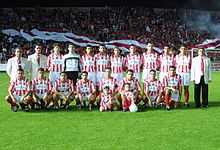
The men's football department is the most importance and longest running of the club. The ground of the team is Ammochostos Stadium.
Nea Salamina's greatest moment was the winning of the Cypriot Cup and the Cypriot Super Cup, in 1990. Its highest ranking in the Cypriot championship was the third place.
In the first five years after its foundation (1948–1953), the team participated in the championships of the Cyprus Amateur Football Federation. In 1953, the club became a member of the Cyprus Football Association (CFA) participating regularly in championships and cups under the auspices of the federation. The football team has participated more than 50 times in Cypriot First Division, being in seventh place in league's ranking. The team claimed unsuccessfully four times to win the championship, finishing all four times in the third position. Participated in a total of three cup finals.
As Cup winner, Nea Salamina played for the first time in a European Cup in 1990, but was excluded from the first round by Aberdeen F.C.. Aberdeen F.C., which had won the 1982–83 European Cup Winners' Cup by defeating Real Madrid in the final [34] it was a very strong team. The first game was at Tsirion Stadium on 19 September 1990, in the presence of 8000 fans. Nea Salamina was defeated 0–2 (half time 0–0).[4][14][35] The replay took place in Aberdeen, at Pittodrie Stadium, on 3 October 1990. Nea Salamina lost 3–0.[4][14][36] The team participated in UEFA Intertoto Cup 1995,[37] and UEFA Intertoto Cup 1997,[38] but exclusive at the first round. At 2000, Nea Salamina, after winning twice KS Vllaznia Shkodër, qualified for the second round, winning FK Austria Wien at Cyprus, but losing 3-0 at Vienna.[39]

The 1965–66 season was one of the best and most painful seasons in the history of Nea Salamina, and remains a landmark in the history of the team so far. According to witnesses and the newspapers of that season, Nea Salamina played the best football in Cyprus. It claimed the championship until the last game of the season and also played for the first time in the Cup final, but failed to win it. The championship began with consecutive wins and claimed the championship with claims.[40] In the away game with APOEL to GSP Nea Salamina preceded by 3–0. In the 62' minute a player of APOEL hit a player of Nea Salamina and a member of APOEL grabbed the flag of assistant referee and extinction. The referee stopped the game according to the provisions of the CFA special circular. The court of CFA decided repeat of the match, ignoring that for the interruption was responsible player and agent for the home team. The trial lasted over three weeks and the team affected, resulting in the defeat of sweeping team, Aris Limassol F.C.. It is noteworthy that Nea Salamina won the booster with rival APOEL.[41] But the injustices continued. In the penultimate match of the tournament Omonia and Salamina equal in the first place of the league and Olympiakos Nicosia followed with one point of difference.[42] In the game against Olympiakos, Nea Salamina preceded by 2–1, the referee added undue delay, giving the opportunity to Olympiakos to score. The excuse of the referee was the injuries of players, something that did not exist according to the newspapers of season. After clashes in the last seconds the game was interrupted. The court of CFA decided replay the match.[43] Until the case is heard, the championship was over. The classification were: 1) Omonia 50 points, 2) Nea Salamina 47 points, 3) Olympiakos 46 points. Nea Salamina with victory over Olympiakos would won the championship after had a better goal difference from Omonia. On 31 May 1966 queues of buses and cars started in the morning from Famagusta to Nicosia. Unfortunately, Nea Salamina defeated 6–3 losing the chance to be crowned champion.[42][43] The best defense in the league, which had received only 15 goals in 19 games, allowed just six in one game, clearly influenced by the events.[42] The team get for the second time the third position. This defeat caused problems and some players did not come back to the team. The result weakened the team was presented with the cup final opponent Apollon Limassol and despite being favorite to win the Cup, defeated 4–2.[42][44] During this season Salamina had the best defense in the league with 21 goals in 20 games for the first and only time.
Women's Soccer
In 2006, Nea Salamina created a women's football department, which took part in the women's events. In the first inning to 2006–07Cypriot First Division, took third place and qualified for the cup final, where lost 1–3 against AEK Kokkinochorion in GSP Stadium. That same year won the Super Cup beating AEK Kokkinochorion with 2–1, in a game that was in Ammochostos Stadium in Larnaca. The club was forced to shut down part of the women's football in 2010 for economic reasons.
Ammochostos Stadium
The original home ground of Nea Salamina FC was GSE Stadium in Famagusta, but due to the Turkish occupation of the town since 1974 they cannot use it.
Ammochostos Stadium, owned by Nea Salamina in Larnaca, has a 5,000-seat capacity and is primarily used for football. The club offices are in the same area. The stadium is named for the town of Famagusta (Greek: Αμμόχωστος; Ammochostos), the original home of Nea Salamina before the Turkish occupation, and was built in 1991 near the refugee camps. The decision to build the stadium was made in 1989; construction began in December of that year, and thanks to club supporters in Cyprus and abroad, the Cyprus Sports Organisation and volunteer labor, the stadium was completed on schedule.[1][45] The first Nea Salamina Famagusta game in the new stadium was played on Saturday, 12 October 1991, against Evagoras Paphos. Nea Salamina won, 4–1.[46] The stadium hosted the 1992 UEFA European Under-16 Championship final on 17 May 1992 between Germany and Spain, which Germany won 2–1.[47]
Volleyball
Men's Volleyball
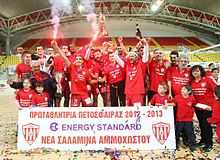
The men's volleyball team of Nea Salamina Famagusta is one of the most powerful teams in Cyprus. With 9 championships, 8 cups and 8 Super Cups it is the second team in trophies after Anorthosis Famagusta FC.[48] The ground of the team is in Limassol, the indoor athletic arena Spyros Kyprianou Athletic Center.
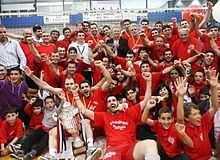
Nea Salamina cultivated the sport of volleyball from its foundation.[49] Since 1954, Nea Salamina organized every summer amateur leagues and cups, which attracted large crowds. In the tournament Took part teams from the province (Nea Salamina, Anorthosis Famagusta FC, the Anagennisi Dherynia, Marathon Kato Varosha, ENAD Agios Memnon).[30]
After the invasion and refugees in 1974, Nikis Georgiou in 1975 proposed the creation of volleyball team in Limassol, in order to maintain the entity of the club. In Limassol there existed since 1974, much of the fans of Nea Salamina. The volleyball team created in 1976. It is one of the 20 founding clubs of the Cyprus Volleyball Federation in 1978. In their first inning in Cyprus Volleyball Division 1 finished in second place. The same position occupied in 1981 and 1983. In 1981 lost the championship to the difference set.[50] In 1983 won the first cup final in winning Anorthosis 3–1. It was the first final the volleyball team participated and the first trophy in club-level men. During 1989–90 won the first championship in its history. At the same time won the cup for the second time. This was followed by another championship the next season and one cup the season after.[48] Since 1998 and until 2003 they achieved something amazing since the dominated of Cypriot volleyball by winning 6 consecutive Championships which is a record for the competition's history. The last four championships were four consecutive treble by winning the championship, the cup and the supercup.[48] Coach of the 6 consecutive Championships was Antonis Constantinou. As a result of this success the team is also nicknamed as the Queen of volleyball in Cyprus.
Overall, the volleyball team won 9 championships, 8 cups and 8 shields. Took the second place 6 times and was finalist of the cup 6 times.
The home stadium of Nea Salamina in the volleyball is Spyros Kyprianou Athletic Center[51] in Limassol.
The team has many European participants.[52] Greater success is the qualifying in the round of 16 in Challenge Cup, winning in the Cypriot civil, Anorthosis, with two victories, over the season 2011–12.[52] It is considered as the greatest success of Cypriot teams in Europe Cups (the same success has AEK Karavas the same season).
Women's volleyball
In 1978 it decided to create women's volleyball team in Limassol, with a view "first, girls to deal with volleyball and second to maintain the entity of the club", which was threatened after the displacement and dispersion of the fans of the team. The first coach was Nikis Georgiou.[53]
In the season 1984–85, the Board decided to suspend the activities of the women's team for financial reasons.[53][54] In their last season was a finalist of the cup. Overall, the presence of 7 years, the women's team was finished second three times (1980–81, 1981–82, 1982–83) and three times was Cup finalist (1979–1980, 1982–83, 1984–85).[55] Indeed, the season 1981–82 had runners on first place with the AEL, but lacked in the proportion of sets in just two sets.[53]
Leagues infrastructure
Nea Salamina also maintains sections U19, U17 and U15. The group of U19 has won 9 championships (most championships in the league), the U17 7 championships (most championships in the league) and U15 6 championships (most championships in the league). The U19 has also won 6 cups (most cup winner).[56]
Classic sport
Nea Salamina of its establishment and until 1974, was a prolific and constant activity on the classic sport. To create a track team pioneered the then Cyprio chanmpionships Nikis Georgiou and Antonis Totsis, who had been expelled from the GSE. The first participation of Nea Salamina in athletics took place in March 1948, just days after the establishment of the club. Participated in the provincial races of Famagusta, occupying the first position. Followed by the second Famagusta's clubs races in 1952 as in 1958. 1970 begins the institution of the Cypriot club races. Nea Salamina won the 5th place among 13 teams. In 1971 and 1977 was ranked as the third position. In 1973 finished in fourth place and in 1974, in the last Cypriot club races, again the fourth position.[57]
Other activities
Before 1974 Nea Salamina had shown high activity in many other areas. Nea Salamina athletes engaged in sports (swimming, boating) during competitions that were organized in Famagusta. In addition, the club had created a table tennis team and organized championships. Also, the club had taken a very active role in the cultural life of Famagusta through outdoor dance performances, theatrical group creation and organization of theatrical performances. Additionally, the club took part in the celebrations of national holidays by participating in parades with the banner of the club.[58]
Nea Salamina London and Nea Salamina New York
In 1974, a group of fans of Nea Salamina living in London, decided to found a club in London called Nea Salamina London, in honor of their team in Cyprus. The Nea Salamina London fights at a topical championship. While maintaining close ties with Nea Salamina. Some players of Nea Salamina Famagusta came from Nea Salamina London.[59]
New York Salamina S.C. is a Greek Cypriot football club in New York, in USA. Founded in 1999 from Cypriot living in New York, who were supporters of the football club Nea Salamina Famagusta. They participate in local amateur leagues in the city of New York.[60]
Turkish Cypriot
Since its founding, Nea Salamina sought to develop friendly relations with the Turkish Cypriots community in Famagusta. An important element was the admission of the Turkish Cypriots to the team. In the early 1950s several Turkish Cypriots footballers i.e. Siekkeris, Nita, Moustafa etc. joined the team of Nea Salamina. When the team joined the CFA, they struggled for two seasons in the Second Division and had as rivals Turkish Cypriot clubs (e.g. Demir Sports, Kenslik Kiounslou, Turkish Club of Famagusta). When the Turkish Cypriot clubs in late 1955 started to withdraw from the tournaments of CFA, Nea Salamina made efforts to convince them to continue. Despite the withdrawal of Turkish Cypriot clubs from the CFA, the Turkish players remained welcome in Nea Salamina. In 1962 Kallikas was transferred to Nea Salamina and in 1970 Neziak who was of Turkish origin was transferred to the club.[61] In 2004 Turkish Cypriots Imam and Oulousoi were transferred to Nea Salamina; by their presence at Nea Salamina these two players became the first Turkish Cypriotic footballers who took part in the championships of CAF in thirty years.[62][63]
On 26 March 2005 Nea Salamina played a friendly football match against the Turkish Cypriot Yeni Mosque (within the transcription Oulousoi), at Ammochostos Stadium, beating them with 6-0. It was the first match between a Greek Cypriot and a Turkish Cypriot club after 50 years. 2500 fans attended the match who sat together in the stands sending a message of peace. The football match was attended by representatives of the political leadership of both communities, local and sports authorities and the Church.[64]
Honours
Football
Men
- Cypriot Cup:
- Winners (1): 1990
- Cypriot Super Cup:
- Winners (1): 1990
- Cypriot Second Division:
- Champions (4): 1955, 1980, 2002, 2004
Women
- Cyprus Super Cup:
- Winners (1): 2007
Volleyball
Men
- Cypriot Championships
- Winner (9): 1989–90, 1990–91, 1997–98, 1998–99, 1999–00, 2000–01, 2001–02, 2002–03, 2012–13
- Cyprus Cup:
- Winner (8): 1982–83, 1989–90, 1991–92, 1999–00, 2000–01, 2001–02, 2002–03, 2010–11
- Cyprus Super Cup:
- Winner (8): 1998, 1999, 2000, 2001, 2002, 2003, 2011, 2013
- U19
- Championships:
- Winner (9): 1994–95, 1998–99, 2004–05, 2005–06, 2006–07, 2007–08, 2010–11, 2011–12, 2012–13
- Cup:
- Winner (6): 1996–97, 1998–99, 2005–06, 2006–07, 2007–08, 2009–10
- U17
- Championships:
- Winner (7): 1991–92, 2002–03, 2004–05, 2006–07, 2009–10, 2011–12, 2012–13
- U15
- Championships:
- Winner (6): 1991–92, 2002–03, 2005–06, 2006–07, 2011–12, 2013–14
Gallery
| Nea Salamina FC fans | ||||||||||||
|---|---|---|---|---|---|---|---|---|---|---|---|---|
|
| Nea Salamina VC fans | ||||||||||
|---|---|---|---|---|---|---|---|---|---|---|
|
References
- ↑ 1.0 1.1 1.2 1.3 1.4 1.5 1.6 1.7 1.8 1.9 1.10 1.11 1.12 1.13 1.14 1.15 ΝΕΑ ΣΑΛΑΜΙΝΑ ΑΜΜΟΧΩΣΤΟΥ. Αθλητισμός (in Greek). Famagusta municipality. Retrieved 2012-08-02.
- ↑ 2.0 2.1 2.2 2.3 2.4 2.5 2.6 2.7 Meletiou 2011, p. 97
- ↑ 3.0 3.1 3.2 3.3 Stilianou & Georgiou 1988, p. 16
- ↑ 4.0 4.1 4.2 4.3 4.4 4.5 4.6 Stilianou & Georgiou 1988, p. 17
- ↑ Stilianou & Georgiou 1988, p. 20
- ↑ Stilianou 1988, p. 20
- ↑ 7.0 7.1 7.2 7.3 7.4 7.5 7.6 7.7 Gavreilides & Papamoiseos 2001, p. 19
- ↑ 8.0 8.1 8.2 8.3 8.4 8.5 Stilianou & Georgiou 1988, p. 21
- ↑ Stilianou & Georgiou 1988, p. 23
- ↑ Meletiou 2011, p. 98
- ↑ Gavreilides & Papamoiseos 2001, p. 51
- ↑ 12.0 12.1 Meletiou 2011, p. 140
- ↑ Stilianou & Georgiou 1988, p. 24
- ↑ 14.0 14.1 14.2 14.3 14.4 14.5 Meletiou 2011, p. 141
- ↑ 15.0 15.1 Meletiou 2011, p. 142
- ↑ 16.0 16.1 16.2 16.3 16.4 16.5 16.6 Stilianou & Georgiou 1988, pp. 37–41
- ↑ Gavreilides & Papamoiseos 2001, p. 23
- ↑ 18.0 18.1 Meletiou 2011, p. 204
- ↑ Γαβριηλίδη 2001, p. 59
- ↑ Stilianou & Georgiou 1988, p. 42
- ↑ 21.0 21.1 Meletiou 2011, p. 212
- ↑ 22.0 22.1 Meletiou 2011, p. 199
- ↑ 23.0 23.1 Stilianou & Georgiou 1988, p. 25
- ↑ Stilianou & Georgiou 1988, p. 189
- ↑ 25.0 25.1 25.2 Stilianou & Georgiou 1988, p. 90
- ↑ Stilianou & Georgiou 1988, p. 78
- ↑ 27.0 27.1 27.2 Stilianou & Georgiou 1988, p. 92
- ↑ Stilianou & Georgiou 1988, p. 91
- ↑ Stilianou & Georgiou 1988, p. 126
- ↑ 30.0 30.1 Stilianou & Georgiou 1988, p. 165
- ↑ 31.0 31.1 31.2 31.3 Stilianou & Georgiou 1988, p. 4
- ↑ 32.0 32.1 Meletiou 2011, p. 196
- ↑ "History". Nea Salamis Famagusta. Retrieved 2013-10-08.
- ↑ "1982–83: Aberdeen sing in the rain". UEFA CUP WINNERS' CUP. UEFA. 16 January 2009. Retrieved 2012-08-04.
- ↑ Stephanidis 2003, p. 206
- ↑ Stephanidis 2003, p. 207
- ↑ "Season 1995". UEFA INTERTOTO CUP. UEFA. 21 August 2008. Retrieved 2012-08-03.
- ↑ "Season 1997". UEFA INTERTOTO CUP. UEFA. 21 August 2008. Retrieved 2012-08-03.
- ↑ "Season 2000". UEFA INTERTOTO CUP. UEFA. 16 January 2009. Retrieved 2012-08-03.
- ↑ Stilianou 1988, p. 66
- ↑ Stilianou 1988, p. 68
- ↑ 42.0 42.1 42.2 42.3 Gavreilides 2001, p. 78
- ↑ 43.0 43.1 Stilianou 1988, p. 73
- ↑ Stilianou 1988, p. 74
- ↑ Stilianou 1998, p. 188
- ↑ Stilianou 1998, p. 191
- ↑ "European U-16 Championship 1992". RSSSF. 28 June 2006. Retrieved 2012-08-02.
- ↑ 48.0 48.1 48.2 "Volley Champions" (in Greek). Cyprus Volleyball Federation. Retrieved 2012-08-18.
- ↑ Stilianou 1998, p. 194
- ↑ Stilianou 1998, p. 195
- ↑ Palais des Sports
- ↑ 52.0 52.1 "Nea Salamina FAMAGUSTA". Confédération Européenne de Volleyball. Retrieved 2012-08-08.
- ↑ 53.0 53.1 53.2 Stilianou 1988, p. 168
- ↑ Stilianou 1998, p. 199
- ↑ Ιστορία του κυπριακού βόλεϊ: Χρυσή Βίβλος Γυναικών (in Greek). Cyprus Volleyball Federation. Retrieved 2012-08-05.
- ↑ Ιστορία του κυπριακού βόλλεϋ: Χρυσή Βίβλος Υποδομής (in Greek). Cyprus Volleyball Federation. Retrieved 2012-08-05.
- ↑ Stilianou 1988, pp. 158–162
- ↑ Stilianou 1988, p. 214
- ↑ Stilianou 1988, p. 155
- ↑ "New York Salamina S.C.". Retrieved 2012-11-03.
- ↑ Stilianou 1998, p. 149
- ↑ "Κύπρος : Ο αθλητισμός ενώνει ..." (in Greek). SportNet. 26 March 2005. Archived from the original on 2013. Retrieved 2012-09-10.
- ↑ Ο καλύτερος Τουρκοκύπριος ποδοσφαιριστής πάει Αλκή (in Greek). Εφημερίδα Καθημαρινή. 13 June 2011. Retrieved 2012-09-10.
- ↑ "Πενήντα χρόνια μετά, το ποδόσφαιρο μας ένωσε ..." (in Greek). typos.com.cy. 26 March 2005. Retrieved 2012-08-19.
Vivliography
- Gavreilides, Michalis; Papamoiseos, Stelios (2001). Ένας αιώνας Κυπριακό ποδόσφαιρο [One century Cypriot football] (in Greek). Nicosia: The writer. ISBN 9963-8720-1-8.
- Meletiou, Giorgos (2011). Κυπριακό ποδόσφαιρο 1900–1960 [Cypriot Football 1900–1960] (in Greek). Nicosia: Power Publishing. ISBN 978-9963-688-87-6.
- Stilianou, Pampos; Georgiou, Neofitos (1988). Νέα Σαλαμίνα, 40 χρόνια πρωτοπόρας αθλητικής πορείας [Nea Salamina, 40 years pioneering sports history] (in Greek). Cyprus: Nea Salamina Famagusta.
- Stilianou, Pampos (1998). 50 χρόνια Νέα Σαλαμίνα 1948–1998 [50 years Nea Salamina 1948–1998] (in Greek). Cyprus: Nea Salamina Famagusta. ISBN 9963-8370-0-X.
- Stephanidis, Giorgos (2003). 40 χρόνια κυπριακές ομάδες στην Ευρώπη [40 years Cypriot teams in Europe] (in Greek). Nicosia: Haravgi. ISBN 9963-8841-1-3.
External links
- Official website (Greek)
- Nea Salamis Αnthem on YouTube
| Wikimedia Commons has media related to Nea Salamis Famagusta. |
| |||||||||||||||||||||||||||||||||||||||||

